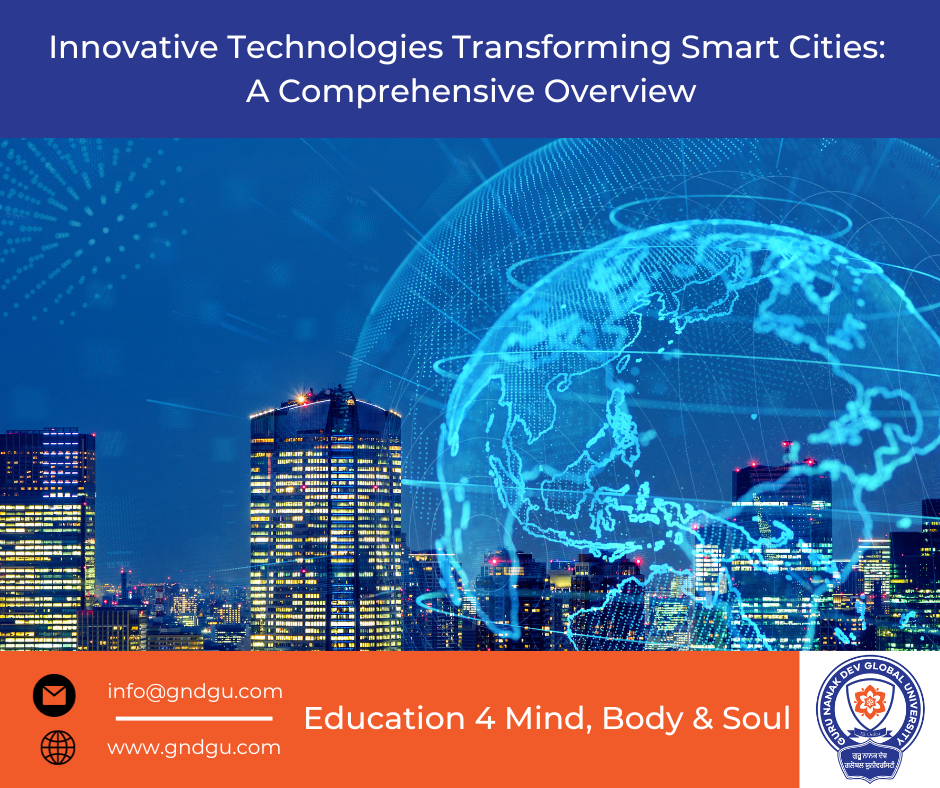Your cart is currently empty!
Innovative Technologies Transforming Smart Cities: A Comprehensive Overview

Smart cities are at the forefront of urban development, harnessing innovative technologies to enhance transportation, water management, building infrastructure, and security. These advancements not only improve the quality of life for residents but also contribute to sustainability and efficiency. In this blog, we’ll explore some cutting-edge technologies in each of these domains and provide real-world examples of how cities are adopting them.
Join FREE online Webinar on Sunday 24, September2023
Sustainable Areas: Transforming NextGen Urban & Rural Areas Together
Click here to learn more about the online webinar
8:00p.m IST (India Time) / 10:30a.m EST (New York)
- Transportation:
Autonomous Vehicles (AVs):
AVs are equipped with a combination of sensors, including LiDAR, radar, cameras, and GPS. Machine learning algorithms process data from these sensors to make real-time decisions on navigation, obstacle avoidance, and speed control. These algorithms use deep neural networks for object recognition and path planning. AVs are revolutionizing urban mobility. They reduce traffic congestion, lower accident rates, and provide convenient transportation.
In USA, Waymo- Google’s self-driving car project, has deployed AVs in Phoenix, Arizona, offering a glimpse of a future with shared autonomous rides.
Intelligent Traffic Management:
AI-powered traffic management systems use real-time data from various sources, including traffic cameras, road sensors, and GPS devices. Machine learning algorithms analyze this data to predict traffic patterns, identify congestion, and adjust traffic signal timings for optimal flow.
Cities like Los Angeles in USA are employing AI-powered traffic management systems that analyze real-time data to optimize traffic flow. Adaptive traffic signals and smart routing apps reduce congestion and minimize commuting time.
2. Water Management:
IoT Sensors for Leak Detection:
IoT sensors placed in water pipelines use ultrasonic technology to detect changes in water flow and pressure. Data from these sensors are transmitted wirelessly to a central control system. Machine learning algorithms analyze this data to identify anomalies, such as leaks or bursts.
Cities like Barcelona in Spain use IoT sensors to detect water leaks in real time. This prevents water wastage, reduces repair costs, and ensures a stable water supply.
Storm-water Management:
Cities employ a combination of green infrastructure and IoT sensors. Green roofs and permeable pavements absorb rainwater, while sensors monitor rainfall intensity and soil moisture levels. Machine learning algorithms predict rainwater runoff and control the release of excess water into drainage systems.
Seattle in USA has implemented a comprehensive stormwater management system that uses permeable pavements, green roofs, and cisterns to absorb rainwater. This reduces flooding and mitigates pollution in water bodies.
3. Building Infrastructure:
Building Energy Management Systems (BEMS):
BEMS consists of sensors, controllers, and software. Sensors monitor parameters like temperature, humidity, and occupancy. Controllers adjust heating, ventilation, air conditioning (HVAC), and lighting based on real-time data. Machine learning algorithms optimize these adjustments to minimize energy consumption while maintaining comfort.
New York City’s One Bryant Park uses BEMS to optimize heating, cooling, and lighting, resulting in significant energy savings.
Green Building Materials:
Green buildings incorporate advanced materials like photovoltaic panels, which convert sunlight into electricity. Rainwater harvesting systems collect and store rainwater for non-potable uses. Insulation materials with high R-values reduce heat transfer through walls, floors, and roofs, improving energy efficiency.
The Edge in Amsterdam is considered one of the greenest buildings globally, using solar panels, rainwater harvesting, and advanced insulation materials to reduce energy consumption.
4. Security:
Video Analytics:
Video analytics systems use computer vision algorithms to process video feeds from surveillance cameras. These algorithms detect objects, track their movements, and classify them. Anomaly detection algorithms identify unusual behavior, triggering alerts. Deep learning models, such as convolutional neural networks (CNNs), are often used for image analysis.
London employs video analytics software to enhance security. The system can detect suspicious behavior in real time and issue alerts to authorities, improving public safety.
Facial Recognition:
Facial recognition systems employ deep learning models, typically CNNs or recurrent neural networks (RNNs). These models extract facial features, create face embeddings, and match them against a database of known faces. Real-time detection and matching require powerful GPUs and efficient model architectures.
In Singapore, facial recognition technology is integrated with public surveillance cameras to identify and locate missing persons or suspects quickly.
While these technologies bring numerous benefits, they also raise important considerations, such as data privacy, cybersecurity, and equitable access. Cities must strike a balance between innovation and the protection of citizens’ rights. As technology continues to evolve, smart cities will remain dynamic ecosystems, adapting to the ever-changing needs of urban life while striving for sustainability, efficiency, and improved quality of life for all residents. These technologies rely on data collection, processing, and analysis to make informed decisions in real time. They contribute to the overarching goals of smart cities, including improved efficiency, sustainability, and enhanced quality of life for residents.